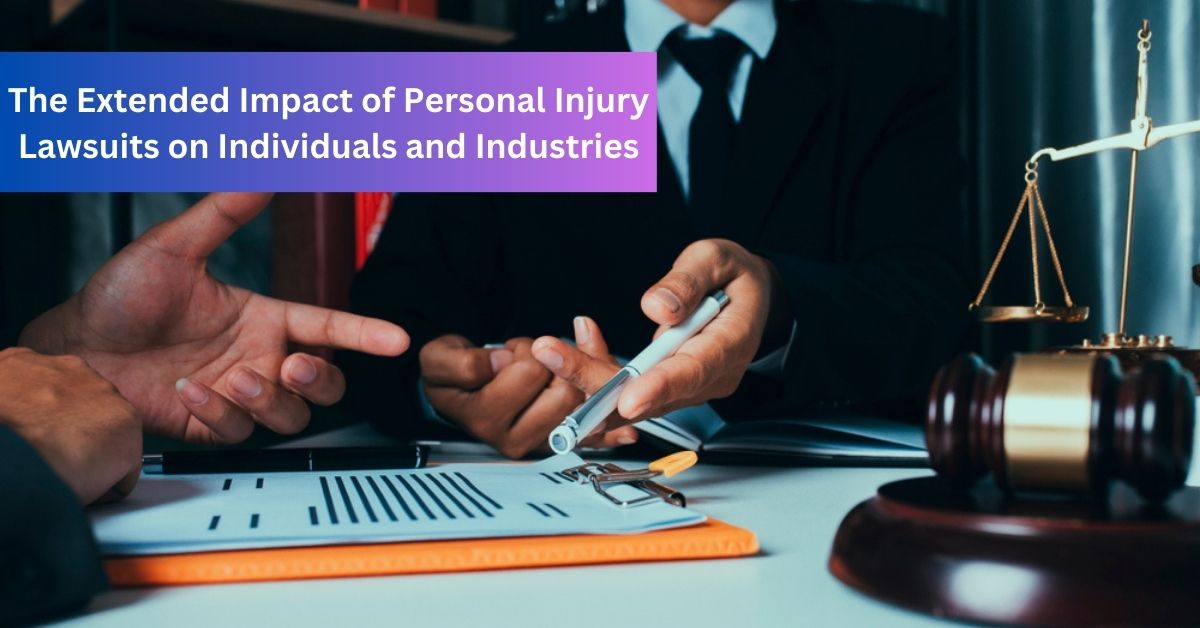The Extended Impact of Personal Injury Lawsuits on Individuals and Industries
Personal injury lawsuits have become an integral part of the legal landscape, shaping the dynamics of both individuals and industries. Beyond the immediate consequences of accidents and injuries, these legal battles have far-reaching effects that resonate across various sectors of society.
From the ripple effects on personal lives to the broader implications for businesses, understanding the extended impact of personal injury lawsuits is crucial. In this article, we’ll explore the far-reaching consequences of personal injury lawsuits, covering emotional, financial, industry, and regional impacts.
The Emotional Toll on Individuals
Personal injury lawsuits exact a profound emotional toll on individuals that extends far beyond the physical injuries sustained. Victims often experience anxiety, depression, and post-traumatic stress disorder (PTSD), impacting their overall well-being.
According to Medical News Today, PTSD affects about 7-8% of the population. The emotional distress may strain personal relationships. Family members and friends become secondary victims as they try to provide support while grappling with the changes.
Coping with the aftermath of an accident requires not only physical rehabilitation but also extensive mental health support to address the trauma endured. This underscores the need for a comprehensive approach to healing.
Financial Ramifications for Plaintiffs and Defendants
The financial aftermath of personal injury lawsuits is a big challenge for both plaintiffs and defendants. Injured parties contend with mounting medical bills and rehabilitation costs while facing potential long-term economic repercussions due to lost wages and diminished earning capacity.
Defendants, often businesses or insurance providers, may experience significant financial setbacks, affecting their ability to operate effectively. The specter of financial liability can lead to increased insurance premiums and, in extreme cases, bankruptcy for businesses. This results in a ripple effect on employees and stakeholders.
As per the American Bar Association, considering litigation finance strategies is advisable in these cases. Litigation finance involves a third party, known as a litigation funder, providing capital to a plaintiff, whether it’s an individual or a business.
This specialty finance firm, unrelated to the lawsuit, invests in the legal action and, in exchange, expects a share of any financial recovery. The arrangement is usually structured as a multiple of the original investment or a percentage of the gross recovery.
Insurance Industry Dynamics
The landscape of personal injury lawsuits profoundly influences the dynamics of the insurance industry. Insurers must recalibrate risk assessments, leading to adjustments in premium rates and coverage availability.
High-profile cases can set precedents, prompting insurance companies to refine policies and adopt more stringent underwriting standards. Moreover, the industry’s response to emerging trends in personal injury litigation shapes overall risk management strategies. This includes addressing the rise of specific claims impacting businesses and individuals seeking coverage.
Impact on Workplace Safety Standards
Personal injury lawsuits act as catalysts for improved workplace safety standards. The fear of lawsuits compels businesses to invest in robust safety measures, ranging from enhanced training protocols to the implementation of advanced safety technologies.
The emphasis on prevention and accountability transforms workplaces into safer environments, benefitting both employees and employers. Consulting experienced firms like Braker White Injury Lawyers or similar others, helps ensure that businesses understand their legal responsibilities, fostering a culture that prioritizes the well-being of workers. This ultimately enhances productivity and reduces the incidence of workplace injuries.
Product Liability and Innovation
The specter of personal injury lawsuits related to defective products has a profound impact on manufacturers and industries. Companies, driven by the need to avoid legal entanglements and safeguard their reputations, invest heavily in research and development to enhance product safety.
This pursuit of innovation benefits consumers by ensuring that products meet higher safety standards. Additionally, as industries evolve in response to legal challenges, competition drives a continuous improvement in the safety and reliability of consumer goods. This results in a win-win scenario for both businesses and the public.
Navigating Local Legal Landscapes
Navigating personal injury lawsuits requires a nuanced understanding of local laws and regulations, which can vary significantly from one jurisdiction to another. Factors such as liability standards, statutes of limitations, and damage caps can impact the strategy employed by both plaintiffs and defendants. Take Colorado, for instance, where specific legal considerations come into play.
According to Justia, Colorado follows a modified comparative negligence system in personal injury cases. This law allows plaintiffs to recover damages even if they bear partial responsibility for the incident, provided their fault does not exceed 50%. Colorado’s statute of limitations for personal injury cases is another crucial factor. Plaintiffs typically have two years from the date of the injury to file a lawsuit.
Additionally, Colorado places a cap on non-economic damages in medical malpractice cases. This limits the amount a plaintiff can receive for pain and suffering, emotional distress, and other intangible losses.
Local nuances extend beyond legal technicalities in Colorado, reaching into specific communities such as Colorado Springs. As one of the state’s largest cities, Colorado Springs presents its own set of legal considerations. With a diverse mix of urban and suburban areas, the city experiences a range of incidents. This includes everything from motor vehicle accidents to outdoor recreational injuries.
In navigating personal injury cases in Colorado Springs, it is crucial to engage the services of a knowledgeable and experienced local attorney. A Colorado Springs personal injury lawyer will not only understand the statewide legal framework but also possess insights into the specific local legal dynamics.
According to Springs Law Group, local attorneys in Colorado Springs offer valuable guidance on how the city’s unique characteristics may impact case outcomes. Local attorneys possess a strong familiarity with local judges and juries. This familiarity enables them to tailor their legal strategies effectively, ultimately improving the chances of achieving favorable outcomes.
Precedents and Industry Practices
The impact of personal injury lawsuits reverberates through legal precedent, shaping the practices and strategies employed by various industries. Landmark decisions set by the courts become pivotal in establishing guidelines for liability, redefining negligence standards, and influencing how damages are determined.
These legal benchmarks create a blueprint for navigating future cases, serving as crucial reference points for legal professionals, businesses, and individuals alike.
Industries closely monitor these legal precedents, recognizing their transformative potential. They adapt their practices to align with the evolving expectations set by the courts, aiming to proactively mitigate risks and avoid potential litigation. This interaction between the legal system and industries cultivates a vigilant culture, motivating businesses to stay aware of current legal standards to ensure compliance.
In summary, personal injury lawsuits transcend individual grievances, leaving enduring imprints on emotional well-being, financial landscapes, and industry practices. From the complexities between insurance dynamics and workplace safety standards to the influence on product liability, these legal battles reshape societal norms.
Evolving precedents become guiding lights, fostering a culture of vigilance and accountability in industries. Localized expertise proves indispensable, emphasizing the significance of navigating legal landscapes with precision. In essence, personal injury lawsuits propel a ripple effect, prompting continuous improvement, adaptability, and a heightened awareness of legal standards.




